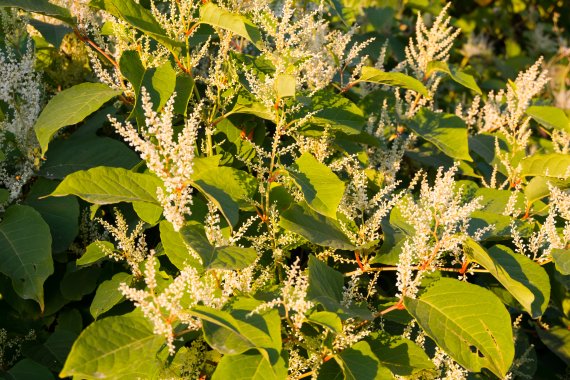©The ‘common’ Japanese knotweed. Photo: Shutterstock
Japanese knotweed, which is spreading along verges and the banks of ditches, is female. The plant spreads by means of vegetative reproduction through rhizomes and shoots. So there was great astonishment two summers ago, when several plants with seeds were suddenly found. How could that be?, Researchers at WUR and the Probos foundation set about finding out, at the behest of the Netherlands Food and Consumer Product Safety Authority (NVWA).
Cross
Not only did the seed turn out to be capable of germinating, but in the greenhouse, plants grew from all the seeds, says researcher Chris van Dijk (Wageningen Plant Research). ‘But the shape of the leaves was different. Longer and redder.’ Further research showed that this was a cross between Japanese knotweed and a Chinese hybrid of Russian vine (Fallopia x conollyana).
In theory, this is bad news. Reproduction through germination gives this weed another way of continuing its invasion of north-west Europe. But so far the impact is not too big. ‘The good news is that we haven’t found this happening outside the greenhouse yet. There seems to be something stopping the seed from germinating in the wild. The hybrid is less vigorous and much less competitive than the Japanese knotweed.’
‘The good news is that we haven’t found it outside the greenhouse yet’
Chris van Dijk, researcher at Wageningen Plant Research
Ban
‘But that doesn’t make it impossible,’ adds Van Dijk. Pollination by another variety of knotweed in the wild or in a garden is not ruled out. ‘And that would then produce a true knotweed with the growth capacity of the parent plants. That is why the NVWA recently advised the government to destroy all the male plants and ban trade in knotweeds.’
Underpinning that advice is the Wageningen research. ‘We’ve been saying for a long time that trade should be banned and the plant should go on the European list of invasive species,’ says Van Dijk. He also argues for better control. ‘The approach has been decentralized and is much too fragmented. Landscape managers are all inventing the wheel for themselves. Actually, it’s just like the situation with the oak processsionary caterpillar.’
Knowledge network
The potential for a new approach is now being explored by the Dutch knowledge network on invasive species set up by Van Dijk and others. The network collates knowledge and expertise on how to tackle invasive species, and lobbies for more research on controlling such species. In the case of the knotweed, Van Dijk has in mind a method which deals with the rhizomes without having to dig up the soil rigorously. ‘For example, by making use of soil pathogens or by applying heat treatment on the spot.’

